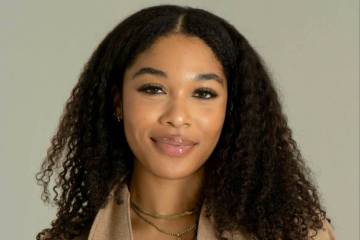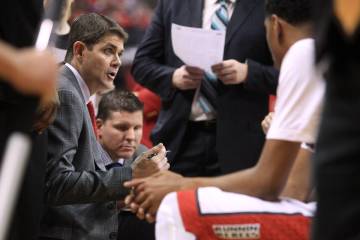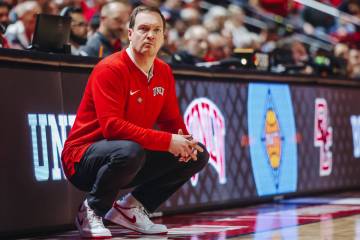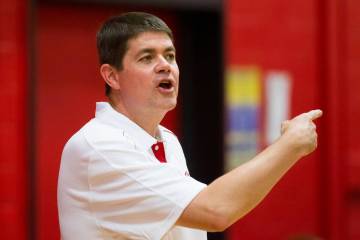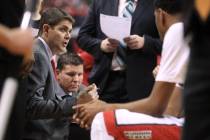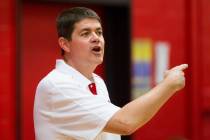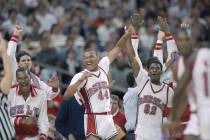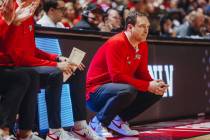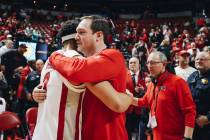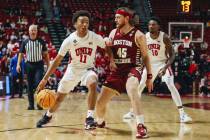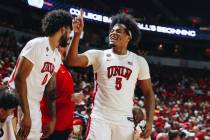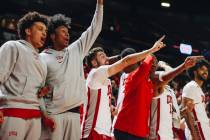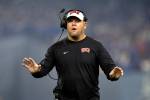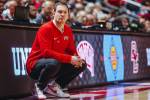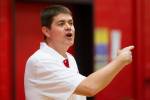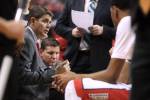Who’s UNLV’s top player? Larry Johnson
When reflecting on it all now, Larry Johnson laughs about his strange twist of fate. He was so close to never attending UNLV, and the person who altered the course of his future was someone he crossed paths with only briefly.
At the time, in early 1987, Johnson was angry, and his mother was heartbroken.
A few years later, he realized he caught the lucky break of a lifetime.
He realized it while leading the Rebels to the 1990 NCAA championship and emerging as the top player in college basketball. And even after 10 years in the NBA, his heart was still with UNLV.
"It was the highlight of my career," he said. "I didn't think that at the time, because you've got all these great things ahead of you. I was drafted No. 1, and I thought I was going to the NBA to kill Michael Jordan and everybody. It didn't happen."
Johnson turned 41 in March. The memories he made in two years at UNLV are lasting.
The 6-foot-7-inch power forward was a two-time All-American and the 1991 John Wooden Award winner, the most prominent player on Rebels teams that went 69-6 and reached two Final Fours.
He ranks 14th on UNLV's career scoring list with 1,617 points in 75 games, for a career scoring average of 21.6 per game, and his field-goal percentage (.643) ranks No. 1.
When the Las Vegas Review-Journal's panel of 25 voters ranked the top 100 Rebels players in history, Johnson emerged No. 1. He filled the top spot on 21 ballots.
Stacey Augmon, Johnson's teammate, ranks No. 2, followed by Sidney Green (1979 to 1983), Armon Gilliam (1984 to 1987) and career scoring leader Eddie Owens (1973 to 1977).
"It wasn't until Larry that we had a chance to win the whole thing," said former UNLV athletic director Brad Rothermel, who ranked Johnson first. "Larry came to play every game."
Marc Ratner has watched every Rebels team since the early 1960s.
"L.J. was really the best player. I can honestly say that's easy," said Ratner, vice president of the Ultimate Fighting Championship and former executive director of the Nevada State Athletic Commission.
Voters were asked to judge players solely by what they accomplished on the floor at UNLV and ignore pro careers and off-court issues.
"It was everything he did off the court. Larry ignited the team," former coach Jerry Tarkanian said. "He was the best player I've ever been around in the locker room. There's no better guy around. Larry was definitely No. 1, in my opinion."
But if things had been slightly different, Johnson might be the top player in Southern Methodist history. As a senior at Skyline High School in Dallas, he signed with SMU, which was "five minutes from the projects" where he grew up, Johnson said.
That's when Ken Pye stepped in and started to change everything. The NCAA had just hit the SMU football program with the death penalty, and Pye took over as the university president. Pye spent 21 years at Duke, and his mission was to clean up SMU athletics during the football crisis.
He looked at two of Johnson's SAT results -- one much higher than the other -- and slammed the door on him.
"Pye said, 'Look here, son, with your test scores you can't play here,' " Johnson recalled. "A couple bad things were written in the paper about me. My high school coach was pissed off. My mom, she thought it was the end of the world."
Johnson headed off to enroll at Odessa College, the middle of nowhere in West Texas.
"I snuck out of Dallas at about 2 in the morning and drove 5½ hours to Odessa on about 40 dollars," he said. "If you look back on it, not going to SMU, that was about the best thing to ever happen to me. It didn't take long to realize it."
Johnson was dominant at the junior-college level, and Georgetown coach John Thompson and Oklahoma's Billy Tubbs pushed hard to sign him. But while playing for USA Basketball, Johnson was assigned Augmon as a roommate, and Augmon was a UNLV recruit.
"I had made up my mind when me and Stacey became cool," Johnson said. "After me and Stacey became cool, then Coach Tark shot in there. He liked to say he recruited me. If you ask him, he's going to tell you, 'I recruited Larry.' "
Which is exactly how Tarkanian remembers it.
"I was there in Dallas almost every week. I didn't let anything slide, either," Tarkanian said. "I thought we were ahead all the time. But I was worried about Thompson because John had such a great reputation with the kids. But John didn't call Larry when he was supposed to.
"I knew Larry was a great player, but I didn't think of him being the No. 1 player in the country, which he definitely was for us."
Pye died of cancer in 1994 in Colorado, four years after Johnson and the Rebels blew out Duke 103-73 in the national championship game in Denver. The Blue Devils avenged that defeat the next year, the lone blemish on the Rebels' 34-1 season.
"Our heads were all in the clouds our second year. But I should speak for myself. My head wasn't in that game," Johnson said. "I can't even watch that game. I played so bad."
Johnson easily could have left UNLV after one year for millions of dollars in the NBA. But he returned because Las Vegas was his home, he was a larger-than-life figure, and there was a desire to cement his and the team's legacy.
The school retired his jersey No. 4 in 1995, the same night Augmon's No. 32 was raised to the Thomas & Mack Center rafters.
Johnson now splits time between homes in Dallas and Las Vegas. He does promotional work for the NBA team he finished his career with, the New York Knicks, and is majority owner of a bottled water and energy drink company. His latest product, Grandmama's Southern Sweet Tea, is set for release in two weeks.
He recently turned down an offer to be an assistant coach for the Chicago Bulls, partly because he has seven children -- four boys and three girls ranging in age from 9 to 17.
In December 2007, Johnson earned his Bachelor of Arts in social science studies from UNLV. He said his late mother, Dortha, always wanted him to return for his degree.
"With no pro team here in Las Vegas, it was overwhelming actually. Everybody couldn't take that," he said. "You had to have a special mind to be in Vegas and be on top like that and get through.
"I think I was more successful and I was more in tune with what was going on in college. In the NBA, it was more of a glamorous life. Everything was catered to you, and it's like you really made it.
"It's the journey to get there, and UNLV was my journey."
Contact reporter Matt Youmans at myoumans@reviewjournal.com or 702-387-2907.





